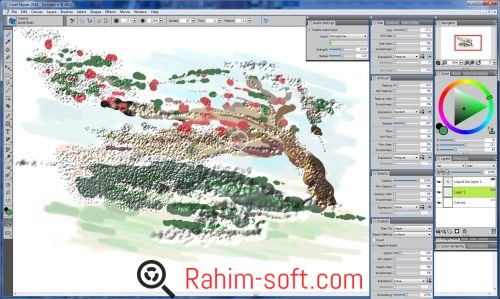
Test your script by playing it.ħ Now play back the script with different tools and colors. This will allow you to change art materials on playback.Ĥ Make your sketch, but be careful not to change colors or drawing tools.ĥ End recording and name your script Sketch.Ħ Choose Select > All, and hit the Delete or Backspace key to clear your canvas. In the Script Options dialog box, disable the Record Initial State option. Pick your color and your drawing tool.Ģ On the Scripts palette, click the palette menu arrow, and choose Script Options. Replaying scripts with different tools is a wonderful way to experiment with a sketch. The trick is to set up the script options correctly in Corel Painter. This is an easy way to experiment with different looks, and an easy effect to create using scripting. Imagine recording a drawing, then playing the drawing back with a different drawing tool. Corel Painter stores copied instructions in the Clipboard, so you can close one script, open another, and paste the instructions there. Click the palette menu arrow and choose Paste. Select the instruction before which you want to paste. To cut, copy and paste parts of your script, select one or more instructions, then click the palette menu arrow and choose Cut or Copy. To select multiple instructions, hold down Shift when clicking them. You can select instructions by clicking them. You can edit a script to change the order of instructions, remove an instruction, or add a segment from a different script. If you have done everything correctly, you should have an image similar to (fig.

Give your script a descriptive name like NTSC756X486.ĩ Close your image file and play back your script. Make sure everything is dropped to the canvas, and stop recording.

In the property bar, click the Convert to Layer button, then drop the layer to the canvas.Ħ Go to Canvas > Canvas Size, and add 200 pixels to the bottom of the canvas.ħ Click on the Text tool in the toolbox, and type in “Audio,” “Job” and “Scene #.”Ĩ Put a thin border around the entire image. Select a color for your border and adjust the size of the stroke.ĥ Choose the Shape Selection tool in the toolbox. Choose Select > Convert To Shape.Ĥ From the Shapes > Set Shapes Attributes dialog box, make sure Stroke is on and Fill is off. Set it to 720 x 486 at 180 ppi (that is a good resolution for printing on a 1440 dpi inkjet printer).ģ Choose Select > All, or use Command+A (Mac OS) or Ctrl+A (Windows). In Corel Painter, scripting offers you, for example, the power to have unlimited “undos.” If you record your work in a script, you can revert to any stage in the project by playing the script back and stopping it at the stage you want.ġ Open the Scripts palette by going to Window > Show Scripts.Ģ Play the Tim Warnock 1 script by clicking the Play button at the bottom of the palette.ģ Play the script again, this time using the Stop or Pause button to stop the playback.Ĥ From the Script Selector, choose another script and play it back.ĥ Click the Single Step button to see the steps the script is following.ġ Start recording by clicking the Record button on the Scripts palette.Ģ Open a new file with a white background. You can literally write your own processes without having to learn programming.

#Corel painter 2016 not tracking strokes software#
No matter how comprehensive the tools in a piece of software might be, there is always something the programmers didn’t think of, or a feature that would have been too bulky or specialized to include, or a repetitive task you would like to automate, such as applying the same effect to each frame in a video clip. Tapping into the power of scripting greatly increases your ability to make software work for you. The default is one day.Įvery good computer graphics program offers the ability to write scripts in one form or another. You can specify how many days Painter keeps the automatically recorded scripts by specifying the number of days in the Preferences > General dialog box. Should your computer crash, there is a good possibility you can retrieve your work session in Painter by playing back the script from the time of the crash. The other automatically records your work session. One type you use with the Record feature. There are two kinds of scripts in Corel Painter.


 0 kommentar(er)
0 kommentar(er)
